Webhouse Training Guide
Webhouse is a
PivotTable report connected to an external data source which is the data
processed in our Great Plains 1Staff back office.
PivotTable Basics
PivotTable areas:
Filters – Used to filter for certain
fields; i.e. by Company, by Job Type (Temp Job or Direct Hire), by Customer, by
Date, etc.
Columns – Pulling fields in this
section will present the data fields in columns; you can also apply a filter on
the field when in columns
Rows – Pulling fields in this section
will present the data fields in rows; you can also apply a filter on the field
when in rows
Values –∑1Staff
Consolidated fields used in this section (discussed below)
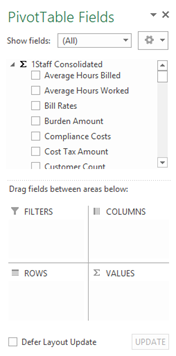
PivotTable layout: my
preference is the Classic Pivot Table layout because it puts the fields you
pull into the Rows section in unique columns which is easiest for filtering.

To change the layout, right click the pivot table and select
“PivotTable Options…”; go to the Display tab and check the box for “Classic
PivotTable layout (enables dragging of fields in the grid)”.
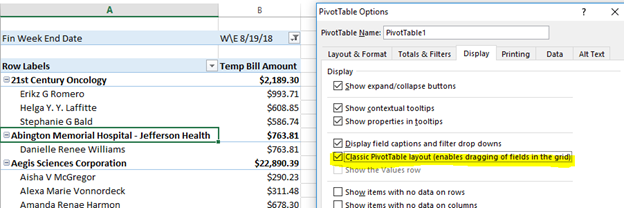
Add/Remove subtotals:
Option 1– Right click the pivot table; the Subtotal field
will be checked if there are subtotals applied.
Select the Subtotal field to add/remove
the Subtotal.
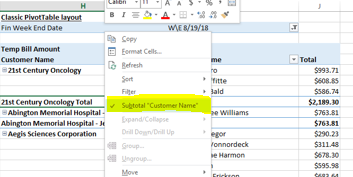
Option 2 – Select pivot table then go to the DESIGN tab in
excel and select Subtotals.
Select “Do Not Show Subtotals” to remove subtotals
or select “Show all Subtotals” to add subtotals.
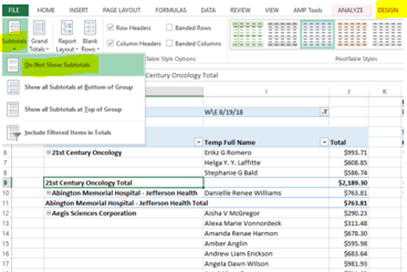
Results:
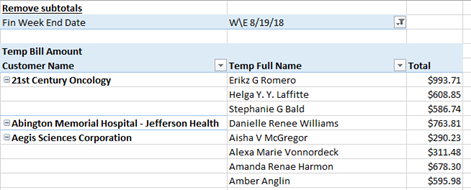
Add/Remove
Grand Totals:
Option 1- Right click the pivot table and select “Remove
Grand Total”.
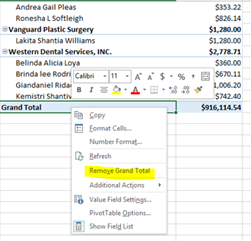
Option 2 – Select pivot table then go to the DESIGN tab in
excel and select Grand Totals. Select “Off for Rows and Columns” to remove grandtotals
or select “On” to add grandtotals.
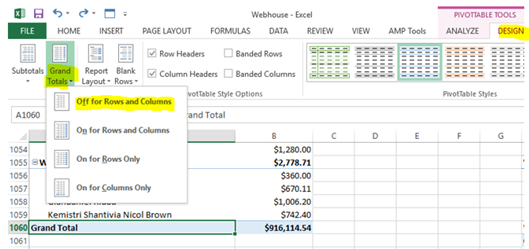
Results:
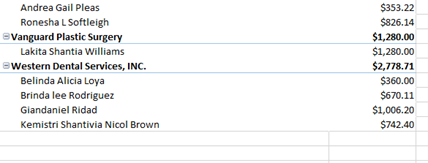
Repeat All Item
Labels:
Select pivot table then go to the DESIGN tab in excel and
select Report Layout -> Repeat All Item Labels

Results:
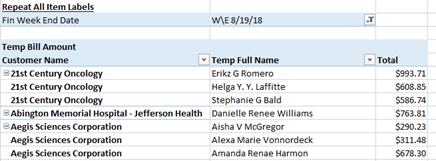
1Staff
Consolidated - Provides financial results; used in VALUES section of
PivotTable
For example: Days/Hours Billed, Days/Hours Worked, Bill
Amount, Pay Amount, Gross Margin, Customer Count, Temp Count
Key Fields Definitions:
· Bill Amount – Temp Bill Amount includes only
Temp Jobs; Bill Amount also includes Direct Hire unless you filter by Job Type
= Temp Job
· Gross Margin –
o Includes Direct Hire unless you filter by Job Type = Temp Jobo Gross Margin Non Burden is simply Bill Amount less Pay Amount; Gross Margin $ is net of all costs (i.e. Pay Amount, Payroll Tax Amount, Burden Amount, etc.)o Percentage (%) and Per Hour metrics are also available
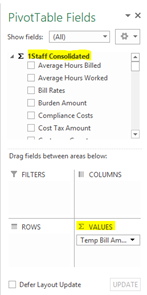
1Staff Company – Webhouse now includes both back offices and therefore, we can now view
consolidated results; you would want to filter by Company Name if you want to
view the results for only one Company
· All Medical Personnel, Inc. – represents the HCS/NAH/ES
back office from 1Staff
· All Medical Personnel, LLC – represents the Locums/Palladium
back office from 1Staff

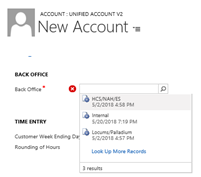
1Staff Consultants – Consultant Name represents the Main Salesperson on the Assignment and is used for commission purposes

1Staff Customers – Includes Customer information
Key Fields Definitions:
· Customer Name – Commonly used when presenting
results by Customer
· Customer Number – Can be used to easily pull in additional
information from 1Staff using vlookups as it is a unique identifier
· Customer Class – Industry from the Account
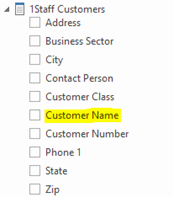
1Staff Invoice
Numbers – Using Invoice Number with Bill Amount can be helpful in
reconciling invoice information with Customers

1Staff Job Start Date – Date will provide the Job Start Date for the Assignment; this is particularly
helpful for Direct Hire Jobs as revenue as recognized based on the Start Date
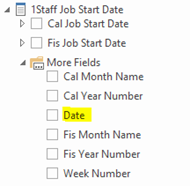
1Staff Jobs – Includes fields from the Assignment including Cost Center, Job Address,
Deactivation and Separation Information
Key Fields Definitions:
· Account Manager - UDF – Represents the Account
Manager on the Assignment and is used for commission purposes
· Account Set ID – Can be used to filter for 3rd parties by filtering for 3RD; also helpful to pull in Vendor Name from 1Staff Temps
(discussed below) to pull in 3rd Party Owner
· Assignment Number – Can be used to pull in data
by Assignment #
· Job Industry - UDF – Represents the Industry
from the Job Order
· Job Order Number – Provides Job Order # for Temp
Jobs only
· Job State Worked – Can be used to filter by
State Worked
· Job Type – Will be commonly used to filter between
Temp and Direct Hire Jobs
· Position Description – Provides the Position Description
from the Assignment
· Recruiter - UDF – Represents the Recruiter on
the Assignment and is used for commission purposes
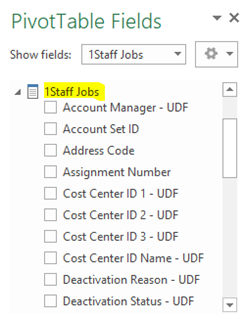
1Staff Office – Provides Office ID and Name from the Assignment

1Staff Pay Types – Provides Pay Type ID and Name
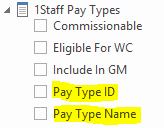
1Staff Positions – Provides Position ID; would use Position Description from 1Staff Jobs (discussed
above) as the Position Description in this section is the Position Description
as defined in the back office.

1Staff SBU – Provides SBU ID and Name from the Assignment

1Staff Temps – Provides Candidate/Contact Information
Key Fields Definitions:
· Employee ID – Represents the Employee ID on the
Contact for Employees only; would not apply to Contractors or Direct Hire
Candidates
· Temp Name – Can pull in by First Name, Last Name
or Full Name
· Temp ID – Represents the Contact ID on the
Contact; can be used to easily pull in additional information from 1Staff using
vlookups as it is a unique identifier
· Temp Office – Temp Office ID and Name represents
the Office on the Contact
· Temp Type – Can be used to filter for Employee,
Contractor or Direct Hire contacts. Please note that all Locums contacts are defined
as Contractors; therefore, you would need to filter by Vendor ID 70017 or
position ID PHARMD (in 1Staff Positions) to filter by Locums employees
· Vendor – Vendor ID and Name provides the Vendor
Information on the Contact for Contractors
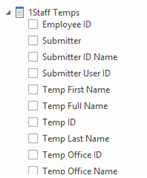
1Staff Timesheet
Date – Represents the dates in which time was worked; for Locums, the
information is also available by Date as time is loaded in the back office by
Day as opposed to only by weekending date.

1Staff Weekend
Date – Represents the weekend date in which time was processed; please
note there can be multiple Timesheet Weekend Dates processed in one Fin Weekend
Date if time was processed late; this is the field we use to present our weekly
results

